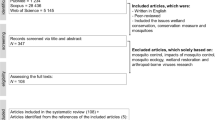Abstract
This synthesis is a short introduction to the Wetlands and Mosquito Control special issue of Wetlands Ecology and Management. The geographic extent of the articles in this Special Issue comprises four continents (America, Asia, Australia, and Europe) indicating a global interest in the issue of wetland ecology and mosquito control. The unifying theme across these diverse papers is the increasingly close collaboration between ecologists, mosquito control, and regulators. Continuing anthropogenic effects on the wetland habitat and demand for mosquito control call for close cooperation between environmental and mosquito control communities. The new generation of wetland managers and mosquito control practitioners understands and accepts the common and compatible goals of preserving the remaining wetlands while addressing the public health concerns. This special issue is dedicated to Bill Walton (1956–2020) who was the driving force behind this endeavor. His career and research illustrate the close relationship between mosquito control and wetland ecology showcasing on how integrating wetland restoration, sustainable mosquito control efforts, and the social and cultural values of the communities will be crucial for the success of wetland management and mosquito control in the twenty-first century.
Similar content being viewed by others
References
Axtell RC (1979) Principles of integrated pest management (IPM) in relation to mosquito control. Mosq News 39:709–718
Bart D, Burdick D, Chambers R, Hartman JM (2006) Human facilitation of Phragmites australis invasions in tidal marshes: a review and synthesis. Wetl Ecol Manag 14:53–65
Batabyal P, Einsporn MH, Mookerjee S, Palit A, Neogi SB, Nair GB, Lara RJ (2014) Influence of hydrologic and anthropogenic factors on the abundance variability of enteropathogens in the Ganges estuary, a cholera endemic region. Sci Total Environ 472:154–161
Becker N, Zgomba M, Petric D, Dahl C, Boase C, Lane J, Kaiser A (2003) Mosquitoes and their control. Kluwer Academic/Plenum Publishers, New York
Beier JC, Keating J, Githure JI, Macdonald MB, Impoinvil DE, Novak RJ (2008) Integrated vector management for malaria control. Malar J 7:S4
Besterman AF, Jakuba RW, Ferguson W, Brennan D, Costa JE, Deegan LA (2022) Buying time with runnels: a climate adaptation tool for salt marshes. Estuaries Coasts. https://doi.org/10.1007/s12237-021-01028-8
Bourn WS, Cottam C (1950) Some biological effects of ditching tidewater marshes. US Fish and Wildlife Service, Portland
Dale PER, Connelly R (2012) Wetlands and human health: an overview. Wetl Ecol Manag 20:165–171
Davidson N (2014) How much wetland has the world lost? Long-term and recent trends in global wetland area. Mar Freshw Res 65:936–941
Ehler LE (2006) Integrated pest management (IPM): definition, historical development and implementation, and the other IPM. Pest Manag Sci 62:787–789
EPA (1975) DDT: a review of scientific and economic aspects ofthe decision to ban its use as a pesticide. US Environmental Protection Agency, Washington
Gedan KB, Silliman BR, Bertness MD (2009) Centuries of human-driven change in salt marsh ecosystems. Annu Rev Mar Sci 1:117–141
Grimstad PR (1994) California group viral infections. In: Beran GW (ed) Handb zoonoses sect. B viral. CRC Press, Boca Raton, pp 71–87
Herman SG, Bulger JB (1979) Effects of a forest application of DDT on nontarget organisms. Wildlife Monographs. Wiley, Hoboken, pp 3–62
Houlahan JE, Findlay CS (2004) Effect of invasive plant species on temperate wetland plant diversity. Conserv Biol 18:1132–1138
Kangmin L (1988) Rice-fish culture in China: a review. Aquaculture 71:173–186
Kirwan ML, Megonigal JP (2013) Tidal wetland stability in the face of human impacts and sea-level rise. Nature 504:53–60
Murray NJ, Clemens RS, Phinn SR, Possingham HP, Fuller RA (2014) Tracking the rapid loss of tidal wetlands in the Yellow Sea. Front Ecol Environ 12:267–272
Neumann B, Vafeidis AT, Zimmermann J, Nicholls RJ (2015) Future coastal population growth and exposure to sea-level rise and coastal flooding—a global assessment. PLoS ONE 10:e0118571
Nyman JA (2021) An overview of the history and breadth of wetland management practices. In: Krauss KW, Zhu Z, Stagg CL (eds) Wetland carbon and environmental management. Wiley, Hoboken, pp 73–101
Osorio JE, Yuill TM (1994) Venezuelan equine encephalitis. In: Beran GW (ed) Handb zoonoses sect. B viral. CRC Press, Boca Raton, pp 33–46
Ren J, Chen J, Xu C, van de Koppel J, Thomsen MS, Qiu S, Cheng F, Song W, Liu Q-X, Xu C, Bai J, Zhang Y, Cui B, Bertness MD, Silliman BR, Li B, He Q (2021) An invasive species erodes the performance of coastal wetland protected areas. Sci Adv. https://doi.org/10.1126/sciadv.abi8943
Rochlin I, James-Pirri MJ, Adamowicz S, Wolfe R, Capotosto P, Dempsey M, Iwanejko T, Ninivaggi D (2012) Integrated Marsh Management (IMM): a new perspective on mosquito control and best management practices for salt marsh restoration. Wetl Ecol Manag 20:219–232
Russell RC (2002) Ross river virus: ecology and distribution. Annu Rev Entomol 47:1–31
Wolanski E, Elliott M (2015) Estuarine ecohydrology: an introduction, 2nd Edition. Elsevier, Amsterdam
Wolfe R, Zarebicki P, Meredith W (2021) The evolution of saltmarsh mosquito control water management practices relative to coastal resiliency in the Mid-Atlantic and Northeastern United States. Wetl Ecol Manage. https://doi.org/10.1007/s11273-021-09817-5
Woodwell GM, Craig PP, Johnson HA (1971) DDT in the biosphere: where does it go? Science 174:1101–1107
Wu N, Liao GH, Li DF, Luo YL, Zhong GM (1991) The advantages of mosquito biocontrol by stocking edible fish in rice paddies. Southeast Asian J Trop Med Public Health 22:436–442
Funding
The authors did not receive specific funding for the preparation of this manuscript.
Author information
Authors and Affiliations
Corresponding author
Additional information
Publisher's Note
Springer Nature remains neutral with regard to jurisdictional claims in published maps and institutional affiliations.
Rights and permissions
About this article
Cite this article
Haas-Stapleton, E., Rochlin, l. Wetlands and mosquito control in the twenty-first century. Wetlands Ecol Manage 30, 899–905 (2022). https://doi.org/10.1007/s11273-022-09860-w
Received:
Accepted:
Published:
Issue Date:
DOI: https://doi.org/10.1007/s11273-022-09860-w




